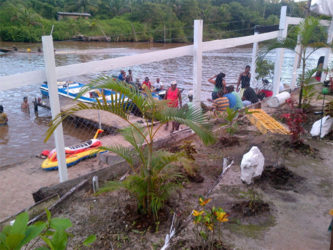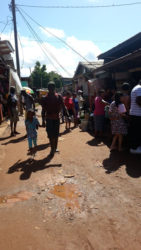Port Kaituma is no bed of roses, though, from, a distance, the stories about a profusion of gold-mining there may create the impression that the community is in a good place, so to speak and that the residents are thriving. The truth is that the gold-mining sector has its own discriminatory propensities and good fortune can be a selective experience.

Raphe’s Fresh Breeze Resort
Before gold, it was manganese. In fact, it was manganese that put Port Kaituma on the map. The community sprung up after manganese was discovered at Matthews Ridge, about 40 miles away. Difficulties associated with accessing Matthews Ridge meant a canal had to be cut from the Kaituma River to get travellers to their intended destination.
The earliest wave of Guyanese from the coastland destined for work in the manganese mines meant that Port Kaituma became increasingly popular. After the operations of the manganese company folded the Barama Company moved to the area. Over a period of more than 25 years, Barama served as the main provider of income for the families at Port Kaituma. Farming thrived for a while but the absence of markets undermined the possibility of sustainability. Perhaps inevitably, residents of the community began to heads for the goldfields.
Not so Norbert Debidin. He stuck with the land, cultivating cassava much of which his wife transforms into cassava bread. The couple markets 25 cassava bread in a hamper for three thousand dollars. The market is small and the dip in gold prices has put a squeeze on the circulation of money. Debidin says that sales are “slow.” Cassava is not lucrative enough to allow for a comfortable living.

Port Kaituma has bred skilled farmers. They cultivate a variety of crops including yam, sweet and bitter cassava, sweet potato, eddo and some cash crops like cabbage, tomato, cucumber, pumpkin, karila, pakchoi and lettuce. Movement of produce to markets outside of Port Kaituma is the biggest challenge. That is what has placed limits on the expansion of agriculture at Port Kaituma and reinforced the risky dependence on gold. Glut has become an occupational hazard of farming in the community.
Exporting agricultural produce from Port Kaituma to the coastal regions is an option but an expensive one. Air freight of cargo costs $125 per pound. There is no way that the Port Kaituma farmers can compete with their coastal competitors, not at those freight prices. If you exercise the option of using the ferry to Georgetown the likelihood of spoilage looms large.
When Stabroek Business visited the area, Debidin was in an upbeat mood. He was part of a group of about 20 persons who had been handed a six-month contract to weed the parapets. The members of the weeding gang are each being paid $50,000 monthly and they were working with a visible measure of enthusiasm. At Port Kaituma people have learnt not to look a gift horse in the mouth.
While he is executing the obligations of his six-month contract with the community, Debidin was waiting for his crops to mature. There were others in the gang who had been working in the mining sector, had been laid off and were turning their hands to an alternative money-earner.
Port Kaituma serves as a sort of assembly point for miners plying their trade in the Region One area. Not surprisingly, myriad commercial influences converge here. Porkknockers apart, those commercial influences include hairdressers, grocers, carpenters and clothing merchants, among others. The drop in gold prices has chased some of them away. The overly optimistic continue to endure.
Many of the Porkknockers have moved and gone to other areas like Mahdia in Region Eight and the Cuyuni/Mazaruni in Region Seven.
Abandoned buildings intended as residential quarters lay empty in plain sight. When we enquired we were told that the previous occupants had returned to their original homes. Gold prices were no longer high enough to keep them there.

Myra Stoby or Mona as she is popularly known isn’t moving. She has been living at Port Kaituma for the past 40 years. She holds the view that gold will “bounce back.” Stoby runs a Variety Store that offers clothing, drapery, groceries, cosmetics and beverages. She runs a canteen on the side. Originally from Berbice she recalls that when gold prices were higher she would dispatch four or five truckloads of rations to the backdam. At weekends she would often double that amount. Over the past three years she’d be lucky to fill a truck every month. There are regular, faithful customers who buy smaller volumes. “I’m not making a huge profit like three years ago but I am able to pay my bills and for that I am thankful,” she says. Her grocery and other supplies come from the city and she travels abroad to restock her clothing supplies.
Consumer prices haven’t budged with the fall in gold prices. Travel around Port Kaituma by car still costs $1,000 per drop. Chicken, beef and pork are being sold at between $700 and $900 per pound. A bag of five tennis rolls set consumers back $500 and a bottle of Guzzler fruit concentrate costs $300. Some people have given Port Kaituma the name “thousand dollar city.”
Raphael Pile is a former policeman who hails from Linden. He appears to be an ambitious businessman who is not afraid to take risks. His first encounter with Port Kaituma was in 2000 when he was posted there as a young constable. After he had parted company with the Force, he returned. He opened a grocery store and subsequently acquired a four-inch dredge and got into mining. Although the cost of gold dropped, the overheads remained constant. He resorted to moving money from the grocery to pump into the mining operation. It didn’t work and he closed the mining operation. He too believes that gold prices will recover, “sometime down the road,” he says. Three years ago ten pennyweight of raw gold fetched between $100,000 and $110,000. These days, Pile says, the same amount of gold is probably worth $60,000. Meanwhile, equipment and maintenance costs and workers’ wages remain unchanged.
Those owners of mining operations who did not either scale down or close their businesses altogether, whether temporarily or otherwise, moved to other presumably more generous gold-bearing areas. At least in those areas the additional gold yield would help compensate for the lower prices.
Pile has diversified into the leisure industry. Raphe’s Fresh Breeze Resort is situated at Canal Bank, a five-minute boat ride from the Port Kaituma water front. He had been looking for an appropriate industry in which he could invest. The resort is a modest outfit where individuals can visit during the weekend to have a bathe and hang with friends. It has the appearance of a small beach: two benabs with stools on which patrons can sit and sip drinks and smaller beach-like accommodation. Raphael’s is modest by standards elsewhere in the country but it offers an insightful glimpse into the leisure and entertainment potential of Guyana’s hinterland region. You can visit the facility any day, free of cost and at weekends, we are told, the place is pretty popular.
Pure water supply, reliable electricity and all-weather roads are, collectively, Pork Kaituma’s main problems. People depend mostly on rain water and during the dry periods they must drive to Citrus Grove to get their supplies from the well there. Some residents have dug ponds and wells in their yards. Those who can afford it have acquired the popular black storage tanks. Wells are costly ventures. A two to four-foot well with all of the infrastructure, can cost in excess of $750,000. Most of the expenditure, around $450,000, goes to the cost of the pump. What is left will cover the cost of the fittings and installation. The community is banking on the creation of state-funded communal wells that will provide a regular and reliable supply of water.
The electricity supply challenges reflect the customary problems of lack of infrastructure and maintenance difficulties. Electricity is generated between 16:00 hrs and 21:00 hrs. Beyond that you generate your own electricity. Many people at Port Kaituma have grown used to protracted periods of darkness.
The roads at Port Kaituma are an unmitigated disaster; huge gashes punctuated sometimes by tiny islands of real road.





